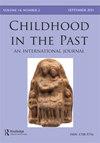Ages and Abilities: The Stages of Childhood and their Social Recognition in Prehistoric Europe and Beyond (SSCIP Monograph 9)
IF 0.5
Q3 ANTHROPOLOGY
引用次数: 6
Abstract
Ages and Abilities explores social responses to childhood stages from the late Neolithic to Classical Antiquity in Central Europe and the Mediterranean and includes cross-cultural comparison to expand the theoretical and methodological framework. By comparing osteological and archaeological evidence, as well as integrating images and texts, authors consider whether childhood age classes are archaeologically recognizable, at which approximated ages transitions took place, whether they are gradual or abrupt and different for girls and boys. Age transitions may be marked by celebrations and rituals; cultural accentuation of developmental stages may be reflected by inclusion or exclusion at cemeteries, by objects associated with childhood such as feeding vessels and toys, and gradual access to adult material culture. Access to tools, weapons and status symbols, as well as children’s agency, rank and social status, are recurrent themes. The volume accounts for the variability in how a range of chronologically and geographically diverse communities perceived children and childhood, and at the same time, discloses universal trends in child development in the (pre-)historic past.年龄与能力:史前欧洲及以后的儿童阶段及其社会认知(SSCIP专著9)
《年龄与能力》探讨了中欧和地中海地区从新石器时代晚期到古典时期的儿童阶段的社会反应,并包括跨文化比较,以扩展理论和方法框架。通过比较骨骼学和考古学证据,以及整合图像和文本,作者考虑儿童年龄类别在考古学上是否可识别,在哪些近似的年龄过渡发生,是渐进的还是突然的,女孩和男孩是不同的。年龄的转变可能以庆祝和仪式为标志;发展阶段的文化强调可能反映在墓地的包容或排斥,与童年有关的物品,如喂养容器和玩具,以及逐渐接触成人物质文化。获得工具、武器和地位象征,以及儿童的机构、等级和社会地位,都是反复出现的主题。这本书解释了一系列不同年代和地理上不同的社区如何看待儿童和童年的变化,同时揭示了(前)历史时期儿童发展的普遍趋势。
本文章由计算机程序翻译,如有差异,请以英文原文为准。
求助全文
约1分钟内获得全文
求助全文
来源期刊

Childhood in the Past
Social Sciences-Anthropology
CiteScore
0.90
自引率
0.00%
发文量
16
期刊介绍:
Childhood in the Past provides a peer-reviewed, interdisciplinary, international forum for the publication of research into all aspects of children and childhood in the past, which transcends conventional intellectual, disciplinary, geographical and chronological boundaries. The editor welcomes offers of papers from any field of study which can further knowledge and understanding of the nature and experience of childhood in the past.
 求助内容:
求助内容: 应助结果提醒方式:
应助结果提醒方式:


